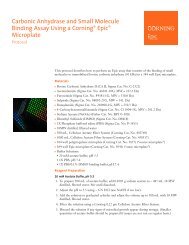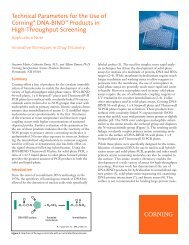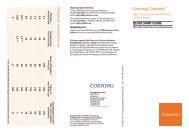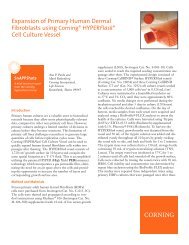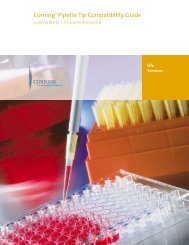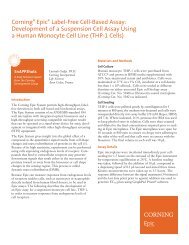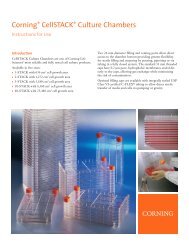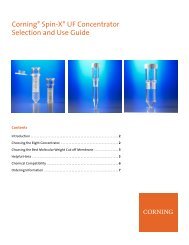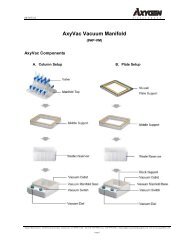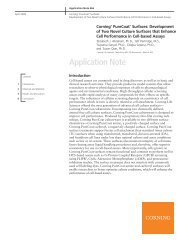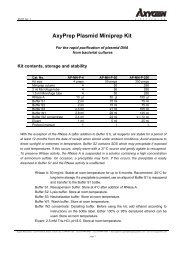Analysis Of CHO Cell Requirements For Assay Miniaturization In ...
Analysis Of CHO Cell Requirements For Assay Miniaturization In ...
Analysis Of CHO Cell Requirements For Assay Miniaturization In ...
You also want an ePaper? Increase the reach of your titles
YUMPU automatically turns print PDFs into web optimized ePapers that Google loves.
THE HTS FORUM<br />
Corning <strong>In</strong>corporated • Science Products Division Volume 8 • Fall 1999<br />
ANALYSIS OF <strong>CHO</strong> CELL REQUIREMENTS FOR ASSAY<br />
MINIATURIZATION IN HIGH-THROUGHPUT SCREENING<br />
THIS<br />
ISSUE ...<br />
<strong>Analysis</strong> of<br />
<strong>CHO</strong> <strong>Cell</strong><br />
<strong>Requirements</strong><br />
for <strong>Assay</strong><br />
<strong>Miniaturization</strong><br />
in High-<br />
Throughput<br />
Screening<br />
Products for<br />
every phase<br />
of the Drug<br />
Development Cycle<br />
From storage to<br />
genomics to HTS and<br />
Test Kit Components,<br />
Corning offers the<br />
most comprehensive<br />
line of products. With<br />
a worldwide distribution<br />
network and<br />
unsurpassed levels of<br />
quality, support and<br />
service, Corning has<br />
you covered no matter<br />
where you are in the<br />
drug development<br />
cycle.<br />
Catherine Ennis, M.S. and<br />
Allison Tanner, Ph.D.<br />
Corning <strong>In</strong>corporated<br />
Science Products Division<br />
Advanced Life Science Products<br />
Portsmouth, NH 03801<br />
Summary<br />
Culture conditions for Chinese<br />
hamster ovary (<strong>CHO</strong>) cells were<br />
varied to analyze cellular requirements<br />
in assay miniaturization for<br />
high-throughput screening. <strong>CHO</strong><br />
cells were seeded into Corning ®<br />
96 well, 96 well half-area and<br />
384 well tissue culture treated<br />
microplates in media volumes<br />
from 25 to 200 µL per well. The<br />
medium was sampled for glucose<br />
and pH measurement. A tetrazolium<br />
reagent was used to evaluate<br />
cellular proliferation, and cells<br />
were harvested for counting. After<br />
24 hours, the number of cells in all<br />
wells had doubled from the initial<br />
seeded quantity. The percentage of<br />
glucose in all wells and volumes<br />
remained above 50% of the value<br />
for the control medium that was<br />
incubated without cells, and pH<br />
remained constant at 7.4. Metabolic<br />
activity as indicated by the<br />
reduction of the tetrazolium<br />
reagent to a soluble, colored formazan<br />
product was similar for<br />
cells in all volumes and formats.<br />
The lower limit of detection was<br />
calculated to be less than 3,000<br />
cells per well in all formats and<br />
volumes, indicating that there<br />
was no decrease in the sensitivity<br />
of the cell proliferation assay<br />
with miniaturization.<br />
<strong>In</strong>troduction<br />
<strong>Cell</strong> culture has become a valuable<br />
and necessary tool for numerous<br />
research laboratories, and many<br />
more groups are adding cell-based<br />
assays to their arsenal of methods<br />
for drug discovery. While some<br />
are analyzing the consequences of<br />
compound addition utilizing cells<br />
that have been genetically manipulated<br />
to announce these effects<br />
through the linkage of a gene of<br />
interest to a reporter molecule,<br />
others concerned about the biological<br />
relevance of these responses,<br />
are using probes that fluoresce<br />
upon activation of signaling pathways<br />
or other changes within cells<br />
(1). Although there are obvious<br />
differences in cells cultured in vitro<br />
from their counterparts in vivo, the<br />
use of cells in culture enhances the<br />
ability to identify and optimize<br />
potential candidates for therapeutic<br />
intervention with more clinical<br />
relevance than those drug leads<br />
provided by assays operating<br />
outside the cellular context.<br />
While non-cell based assay miniaturization<br />
presents many difficulties<br />
in dispensing and handling minuscule<br />
quantities of reagents, as well<br />
as determining the appropriate<br />
proportions of reactive components<br />
to provide the signal intensity necessary<br />
to discern potential drug<br />
candidates, cell-based assay miniaturization<br />
poses all of these problems<br />
and more. The entire range<br />
of environmental requirements to<br />
culture cells with specialized functions<br />
lie outside the scope of this<br />
article, but basic to all cells in<br />
monolayer culture are the need to<br />
maintain asepsis, a receptive substrate<br />
for adhesion, proper incubation<br />
temperature, medium of the<br />
appropriate constitution and volume<br />
to support cell establishment<br />
and the necessary gas phase. Since<br />
<strong>CHO</strong> cells are commonly used in<br />
high-throughput screening for the<br />
ease with which they can be manipulated<br />
and maintained, this article<br />
analyzes culture conditions for<br />
<strong>CHO</strong> cells in assay miniaturization.<br />
Materials and Methods<br />
<strong>Cell</strong> Culture<br />
<strong>CHO</strong> K1 cells from American<br />
Type Culture Collection (Rockville,<br />
MD) (ATCC No. CRL 9618) were<br />
cultured in T-225 flasks (Corning<br />
Cat. No. 3001) to confluence in<br />
Hams F-12 basal medium, pH 7.4<br />
(Cat. No. 12615F, BioWhittacker,<br />
Walkersville, MD), supplemented<br />
with 10% (v/v) FBS (Cat. No.<br />
14501F, BioWhittaker, Walkersville,<br />
MD) containing 1% (v/v) sodium<br />
pyruvate (Cat. No. 13115E,<br />
BioWhittaker, Walkersville, MD)<br />
and 1% (v/v) L-Glutamine (Cat.<br />
No. 17605E, BioWhittaker,<br />
Walkersville, MD) in an atmosphere<br />
of humidified 5% CO 2 in<br />
air at 37°C. The confluent cells<br />
were harvested and dispensed into<br />
clear, tissue culture treated 96 well<br />
(Corning Cat. No. 3596), 96 wellhalf<br />
area (Corning Cat. No. 3696),<br />
and 384 well microplates (Corning<br />
Cat. No. 3701) using a LabSystems<br />
Multidrop 384 dispensing unit<br />
(Cat. No. 1507010, Helsinki,<br />
Finland) at varying densities and<br />
media volumes.<br />
Culture Conditions, <strong>Cell</strong>ular<br />
Adherence, Metabolic Activity<br />
Culture conditions, cellular metabolism<br />
and adherence were analyzed<br />
( in quadruplicate) following<br />
timed incubations in microplates.<br />
Medium of interior and perimeter<br />
Continued inside
The HTS <strong>For</strong>um<br />
wells was examined for pH changes<br />
using indicator strips (Cat. No. 9582,<br />
EM Science, Gibbstown, NJ). Glucose<br />
concentrations were determined enzymatically<br />
(Cat. No. 510A, Sigma<br />
Diagnostics, St. Louis, MO) according<br />
to manufacturer’s instructions (Procedure<br />
No. 510) following collection<br />
of conditioned media and media incubated<br />
without cells, at timed intervals.<br />
Glucose concentrations were measured<br />
on a SpectraMax 250 (Molecular<br />
Devices, Sunnyvale, CA) at 450 nm in<br />
clear 96 well microplates (Corning ®<br />
Cat. No. 3370). <strong>Cell</strong>ular adherence was<br />
examined following removal of conditioned<br />
media and washing of nonadherent<br />
cells from microplate wells<br />
with Dulbecco’s Phosphate Buffered<br />
Saline (DPBS) (Cat. No. 17512F,<br />
BioWhittaker, Walkersville, MD). <strong>For</strong><br />
3 and 24-hour incubations, adherent<br />
cells were photo-documented at 400X<br />
using an Olympus microscope with an<br />
Olympus OEV 142 monitor and OEP<br />
color video printer (Optical <strong>Analysis</strong><br />
Corp, Nashua, NH). Adherent cells<br />
were washed once with DPBS and<br />
enzymatically detached from microplate<br />
wells with 50 µL of trypsin/ versene<br />
(Cat. No.17161E, BioWhittaker,<br />
Walkersville, MD) and incubation at<br />
37°C for five minutes. Detached cells<br />
were collected and resuspended in<br />
950 µL of media and counted manually<br />
using a hemocytometer. Metabolic<br />
activity of <strong>CHO</strong> K1 cells was examined<br />
with <strong>Cell</strong> Titer 96 ® AQ ueous One Reagent<br />
MTS <strong>Assay</strong>s (Cat. No. G358B, Promega,<br />
Madison, WI). Reactions were conducted<br />
according to manufacturer’s<br />
instructions as well as modified by<br />
increasing the proportion of MTS<br />
added according to the number of cells<br />
seeded, to compare the addition of<br />
MTS reagent based upon cell numbers.<br />
At timed intervals following incubations<br />
at 37°C, optical densities were<br />
determined at 490 nm on the Wallac<br />
Victor 2 1420 Multilabel Counter<br />
(EG&G Wallac, Turku, Finland). The<br />
adhesion of <strong>CHO</strong> K1 cells was also<br />
examined in black opaque 384 well<br />
(Corning ® Cat. No. 3713) and 96 well<br />
(Corning Cat. No. 3603) microplates<br />
Fluorescence intensity (cps x 10 6 )<br />
50<br />
40<br />
30<br />
20<br />
10<br />
0<br />
50,000 25,000 12,500 6,250 12,500 6,250 1,325 1,562<br />
Figure 2. Percent Glucose Remaining. Glucose concentrations were determined enzymatically and<br />
measured spectrophotometrically at 450 nm in 96 well microplates following collection of conditioned<br />
media and media incubated without cells, at timed intervals. The percent glucose remaining was calculated<br />
from the glucose concentration in the media sample incubated without cells at each timepoint. Error bars<br />
indicate (+/-) the standard deviation of four replicates.<br />
over time, using Vybrant <strong>Cell</strong> Adhesion<br />
<strong>Assay</strong> Kits (Cat. No. V-13181, Molecular<br />
Probes, Eugene, OR). <strong>CHO</strong> K1 cells<br />
Number of cells seeded per well<br />
96 wells<br />
384 wells<br />
Figure 1. Flourescence intensity after 90 minutes. The adhesion of <strong>CHO</strong> K1 cells was examined over<br />
time using Vybrant( <strong>Cell</strong> Adhesion <strong>Assay</strong> Kits (Cat. No. V-13181, Molecular Probes, Eugene, OR). <strong>CHO</strong><br />
K1 cells were harvested and manually dispensed at 50,000, 25,000, 12,500, 6,250 cells per 100 µL and<br />
12,500, 6,250, 3,125, 1,562 cells per 25 µL into 96 well black opaque and 384 well microplates, respectively.<br />
Fluorescence intensity was measured (as stated in Materials and Methods) and increased as the<br />
number of cells initially seeded increased. Representative data using the 90 minute timepoint is shown.<br />
Percent Glucose Remaining<br />
120<br />
100<br />
80<br />
60<br />
40<br />
20<br />
0<br />
96/100 µL 96/200 µL 96 half/50 µL 96 half/100 µL 384/25 µL 384/50 µL<br />
<strong>For</strong>mat/volume<br />
0<br />
2 hr<br />
4 hr<br />
24 hr<br />
were harvested as stated previously and<br />
manually dispensed at 50,000, 25,000,<br />
12,500, 6,250 cells per 100 µL and
Table 1. MTS Measure of Metabolic Activity<br />
Number of Standard Standard Standard<br />
Plate cells seeded Volume MTS 2 hr. deviation 4 hr. deviation 24 hr. deviation<br />
96 well 50,000 100 µL 20 µL 0.340 0.04 0.519 0.06 0.602 0.01<br />
40 µL 0.483 0.04 0.573 0.09 0.677 0.04<br />
96 well 50,000 200 µL 20 µL 0.237 0.03 0.238 0.02 0.633 0.04<br />
40 µL 0.320 0.04 0.389 0.04 0.937 0.09<br />
half-area 25,000 50 µL 10 µL 0.405 0.10 0.542 0.12 0.740 0.05<br />
20 µL 0.492 0.10 0.850 0.04 0.800 0.07<br />
half-area 25,000 100 µL 10 µL 0.228 0.04 0.350 0.02 0.745 0.05<br />
20 µL 0.266 0.10 0.361 0.15 0.864 0.21<br />
384 well 12,500 25 µL 5 µL 0.355 0.02 0.369 0.09 0.527 0.06<br />
10 µL 0.466 0.06 0.567 0.10 0.671 0.02<br />
384 well 12,500 50 µL 5 µL 0.196 0.05 0.285 0.14 0.570 0.06<br />
10 µL 0.219 0.04 0.391 0.11 0.664 0.05<br />
Comparison of metabolic activity in <strong>CHO</strong> K1 cells seeded in different volumes in microplate wells of the same surface area for 96 well, 96 well half-area,<br />
and 384 well microplates using <strong>Cell</strong> Titer 96 ® AQ ueous One Reagent MTS <strong>Assay</strong>s (Cat. No. G358B, Promega, Madison, WI). Reactions were conducted according<br />
to manufacturer’s instructions as well as modified to compare the addition of MTS reagent based upon cell numbers. At timed intervals, optical densities were<br />
determined at 490 nm on the Wallac Victor 2 1420 Multilabel Counter (EG&G Wallac, Turku, Finland).<br />
12,500, 6,250, 3,125, 1,562 cells per<br />
25 µL into 96 well and 384 well microplates,<br />
respectively. All reactions were<br />
carried out according to manufacturer’s<br />
instructions and fluorescence intensity<br />
was detected using an LJL Biosystems<br />
“Analyst” (LJL Biosystems, Sunnyvale,<br />
CA) as follows: comparator conversion,<br />
attenuator = medium, units = cps, plate<br />
= Costar ® 96 well solid, 384 well solid,<br />
polarizer settling time = 150ms, z-height<br />
= 2.2 mm, integration time = 100,000<br />
µs, excitation filter 485 nm, emission<br />
filter 615 nm.<br />
<strong>Assay</strong> <strong>Miniaturization</strong> and Sensitivity<br />
The sensitivity after miniaturizing the<br />
<strong>Cell</strong> Titer 96 ® AQ ueous One Reagent MTS<br />
<strong>Assay</strong> (Cat. No. G358B, Promega,<br />
Madison, WI) was compared in clear,<br />
tissue culture treated 96 well (Corning<br />
Cat. No. 3596), 96 well-half area<br />
(Corning Cat. No. 3696), and 384 well<br />
microplates (Corning Cat. No. 3701)<br />
was compared. <strong>CHO</strong> K1 cells were<br />
harvested as stated previously and manually<br />
dispensed at 100,000, 50,000,<br />
25,000, 12,500, 6,250, 3,125, 1,562<br />
cells per 100 µL and 200 µL into 96<br />
well microplates, 50 µL and 100 µL<br />
into 96 well-half area microplates, and<br />
25 µL and 50 µL into 384 well microplates.<br />
All reactions were carried out<br />
according to manufacturer’s instructions.<br />
Following 3 hour incubations at<br />
37°C, optical densities were determined<br />
at 490 nm on the Wallac Victor 2 1420<br />
Multilabel Counter (EG&G Wallac,<br />
Turku, Finland).<br />
Results and Discussion<br />
The conditions for <strong>CHO</strong> cell-based assay<br />
miniaturization were examined in 96<br />
well, 96 well half-area, and 384 well<br />
tissue culture treated microplates in an<br />
effort to determine rapid, cost effective<br />
methods to identify potential therapeutic<br />
compounds. To produce the number<br />
of cells necessary to seed a large number<br />
of microplates, cells were first grown to<br />
confluence in T-225 flasks. After harvesting,<br />
dilutions of cells were seeded in<br />
volumes of 100 µL and 25 µL per 96 and<br />
384 wells, respectively. The Vybrant <br />
<strong>Cell</strong> Adhesion <strong>Assay</strong> was used to assess<br />
the effect of the quantity of cells seeded<br />
on the number of adherent cells at incubation<br />
times up to three hours. As<br />
anticipated, an increase in fluorescence<br />
intensity correlated with an increase in<br />
the number of cells seeded. This appears<br />
to indicate that increasing the number<br />
of cells seeded leads to an increased<br />
number of adherent cells (Figure 1). It<br />
was also observed that the 384 well<br />
plates gave a higher fluorescent signal<br />
for the same densities (12,500 and<br />
6,250) plated in 96 well microplates.<br />
This was presumably a result of higher<br />
plating density per unit area for the<br />
same number of cells. Furthermore, the<br />
relative fluorescence obtained with just<br />
1,325 cells per well in a 384 well microplate<br />
was comparable to 6,250 per well<br />
in a 96 well microplate. This indicates<br />
that higher plating densities obtained in<br />
384 well microplates should be beneficial<br />
for cell-based analysis by enabling<br />
higher signals to be obtained with<br />
fewer cells. <strong>Analysis</strong> of culture conditions<br />
in decreasing volumes of media<br />
were compared across the three microplate<br />
formats after increasing times of<br />
incubation, using a combination of pH<br />
measurement, glucose utilization, cell<br />
proliferation and metabolic assessment.<br />
<strong>Cell</strong>s were seeded into the microplate<br />
wells so that a confluent monolayer<br />
would be achieved after 24 hours of<br />
incubation. Two different volumes of<br />
media were used per microplate format.<br />
To retain the appropriate oxygen and<br />
carbon dioxide tensions for monolayer<br />
cells in culture, it is recommended that<br />
the depth of the medium be in the<br />
range of 2 to 5 mm, depending on specific<br />
cell type and growth conditions<br />
(2). Since cells in culture use glycolysis<br />
as the primary pathway to provide<br />
metabolic energy (2), the amount of<br />
glucose remaining in the medium pro-
Fall 1999<br />
vides a measure of the adequacy of<br />
media volume to support cells. The<br />
amount of glucose in the medium<br />
appeared to be utilized gradually over<br />
time in all microplate wells containing<br />
cells, while the pH remained constant<br />
at 7.4. The percentage of glucose in all<br />
wells remained above 50% of the value<br />
for the control medium that was incubated<br />
in absence of cells (Figure 2). The<br />
rate of glucose depletion seemed within<br />
reasonable limits of experimental variation<br />
for all the microplates with different<br />
volumes of media. This suggests<br />
that in spite of miniaturizing, the metabolic<br />
rates of the cells was unaltered.<br />
Equal numbers of cells were seeded in<br />
different volumes of media to determine<br />
if it took longer for cells to settle<br />
and adhere in a greater depth of media.<br />
While the initial cell counts at one and<br />
two hours seemed to support this, by<br />
three hours cell numbers equivalent to<br />
the amount seeded were counted in all<br />
wells. At 24 hours, the number of cells<br />
in all wells had doubled from the initial<br />
seeded quantity and there were no differences<br />
visible microscopically (Figure<br />
3). MTT, is a tetrazolium compound<br />
that has long been used as an indicator<br />
of cell proliferation, viability and cytotoxicity<br />
(3). MTT is reduced by metabolically<br />
active cells to an insoluble<br />
formazan product, the absorbance of<br />
which is directly proportional to the<br />
number of living cells in culture (4).<br />
<strong>Cell</strong> Titer 96 ® AQ ueous One Reagent<br />
(Promega) combines MTS, a related<br />
tetrazolium compound, with phenazine<br />
methosulfate (PMS), an electron coupling<br />
reagent, to produce a water-soluble<br />
formazan product after reduction<br />
by living cells (5). This MTS reagent<br />
was used to assess the viability of cells<br />
incubated in reduced media volumes as<br />
well as providing a measure of assay<br />
miniaturization sensitivity upon miniaturization.<br />
<strong>In</strong>structions included with<br />
the reagent suggest that the proportion<br />
of the MTS reagent should be kept constant<br />
with the volume of media in the<br />
assay, but to better gauge whether the<br />
cells were influenced by media volume,<br />
the addition of the MTS reagent was<br />
also varied based on the number of<br />
cells seeded. Since the additional media<br />
diluted the absorbance of the soluble<br />
formazan product, the differences in<br />
absorbance as a function of media volume<br />
were more pronounced at the early<br />
timepoints (2 and 4 hours). However,<br />
incubation for 24 hours seemed to indicate<br />
that there was little difference in<br />
metabolic activity between cells seeded<br />
into microplate wells with the same<br />
growth surface area in different media<br />
volumes. Lower media volumes with a<br />
higher proportion of MTS generally<br />
lead to greater absorbance (Table 1). To<br />
determine assay sensitivity upon miniaturization,<br />
the MTS reagent was used<br />
for another experiment in the proportions<br />
suggested by the manufacturer.<br />
Equal numbers of cells were seeded<br />
regardless of the surface area available<br />
A<br />
B<br />
Figure 3. At 3-hours (a) and 24-hours (b) post-seeding, adherent <strong>CHO</strong> K1 cells in 25 and 50 µL per 384 microplate well, 50 and 100 µL per 96 half-area microplate<br />
well, and 100 and 200 µL per 96 microplate well were photo-documented at 400x using an Olympus microscope with an Olympus OEV 142 monitor and OEP<br />
color video printer (Optical <strong>Analysis</strong> Corp, Nashua, NH). Upon visual inspection, there were no obvious differences in cells seeded in wells of different surface<br />
areas, in any of the assessed volumes, at 3 or 24 hours.
The HTS <strong>For</strong>um Fall 1999<br />
for attachment, into wells of all three<br />
microplate formats. The greatest<br />
absorbance for the lowest cell number<br />
occurred in Corning ® 384 well microplates<br />
irrespective of the volume of media<br />
used for growth, with the 96 well and<br />
96 well half-area microplates in close<br />
approximation (Figure 4). These results<br />
strongly support assay miniaturization<br />
for reagent and cost reduction.<br />
Conclusions<br />
As evidenced by the amount of glucose<br />
remaining in the wells, cell proliferation<br />
and metabolic activity, reduction of<br />
media volumes to 25 and 50 µL per<br />
well in 384 well microplates, 50 and<br />
100 µL per well in 96 half-area microplates,<br />
is suitable for maintaining <strong>CHO</strong><br />
cells in culture for 24 hours. If time is<br />
of the essence and cells are abundant,<br />
increasing the number of cells seeded<br />
will lead to an increased number of<br />
adherent cells up to times of less than<br />
three hours of incubation. Results<br />
demonstrate that assay sensitivity is<br />
maintained down to the detection of<br />
less than 3,000 cells in Corning 384<br />
and 96 well half-area microplates.<br />
Enhancement of signal intensity upon<br />
miniaturization of these cell-based assays<br />
into 384 well microplates appears to be<br />
due to the increased plating density per<br />
unit area for the same number of cells.<br />
The benefits of assay miniaturization<br />
for pharmaceutical discovery include<br />
conservation of biological reagents and<br />
chemical compounds, reduction in the<br />
waste stream, and more rapid screening<br />
of potential therapeutic candidates.<br />
Corning is supporting these efforts with<br />
an array of microplates for cell-based<br />
and non-cell based assays used in highthroughput<br />
screening.<br />
• Corning 96 well half-area microplates<br />
provide a novel way to decrease the<br />
consumption of biological reagents<br />
and chemical compounds without<br />
costly automation format retooling.<br />
Absorbance at 490 nm<br />
2.0<br />
1.8<br />
1.6<br />
1.4<br />
1.2<br />
1.0<br />
0.8<br />
0.6<br />
0.4<br />
0.2<br />
0<br />
384/25 µL<br />
384/50 µL<br />
half-area/50 µL<br />
half-area/100 µL<br />
96/100 µL<br />
96/200 µL<br />
Media 1,562 3,125 6,250 12,500 25,000 50,000 100,000<br />
Number of cells seeded<br />
Figure 4. MTS assay miniaturization. The sensitivity of the <strong>Cell</strong> Titer 96 ® AQ ueous One Reagent MTS <strong>Assay</strong><br />
(Cat. No. G358B, Promega, Madison, WI) in 96 well, 96 well half-area, and 384 well microplates was<br />
compared. <strong>CHO</strong> K1 cells were harvested as stated (in Materials and Methods), and dispensed at 100,000,<br />
50,000, 25,000, 12,500, 6,250, 3,125, 1,562 cells per 100 µL and 200 µL into 96 well microplates, 50 µL<br />
and 100 µL into 96 well-half area microplates, and 25 µL and 50 µL into 384 well microplates. All reactions<br />
were carried out according to manufacturer’s instructions. Measurements were spectrophotometric at<br />
490 nm, following three hour incubations at 37°C.<br />
• Corning offers a multitude of 384<br />
well microplates to augment throughput<br />
and conserve biological reagents<br />
and cehmical compounds in laboratories<br />
that have incorporated the 384<br />
well automation format.<br />
• Corning 96 well half-area and 384<br />
well microplates help to reduce the<br />
waste stream and overall cost of<br />
high-throughput screening.<br />
• Corning 96 well half-area and 384<br />
well microplates enable assay miniaturization<br />
without loss of sensitivity<br />
to help prevent missing potential candidates<br />
for therapeutic intervention.<br />
References<br />
1. Okun, I. and Veerpandian, P. 1997.<br />
Nature Biotechnology 15:287-288.<br />
2. Freshney, I.R. 1994. Culture of Animal<br />
<strong>Cell</strong>s, A Manual of Basic Technique,<br />
third edition., Wiley-Liss, <strong>In</strong>c. New<br />
York, NY.<br />
3. Mosmann, T. 1983. J. Immunol.<br />
Methods 65:55-63.<br />
4. Celis, J.E. 1998. <strong>Cell</strong> Biology, A<br />
Laboratory Handbook, second edition,<br />
Academic Press, San Diego, CA.<br />
5. Promega Technical Bulletin. 1996.<br />
No.169, <strong>Cell</strong>Titer 96 AQ ueous Non-<br />
Radioactive <strong>Cell</strong> Proliferation <strong>Assay</strong>,<br />
Promega, Madison, WI.<br />
We would like to thank Elizabeth<br />
Martin and Jennifer Brackett of<br />
Corning <strong>In</strong>corporated in Portsmouth,<br />
NH, for their assistance with the completion<br />
of experiments for this article.



